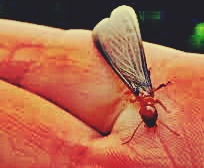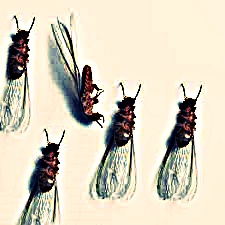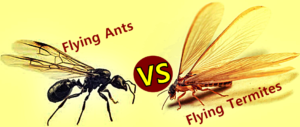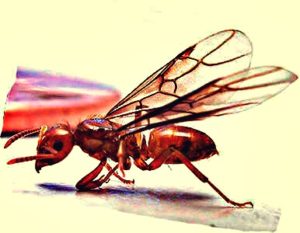
Flying termites are one of the most damaging pests found in houses. Termite colonies tend to mature in 3 to 6 years and then start producing female and male alates, or flying termites, or reproductive stage termites. Such alates fly out from their current colonies to mate and create new termite colonies someplace else. Till the time a termite colony is present, the insects will feed on wood and often generate expensive damage to homes and buildings.
A swarm of flying termites near your house may be an indication of a big colony in the garden, yard, or some other location close by. People who find numerous flying termites inside their homes, or notice them coming out from the exterior of the house, or see their shed wings around windows or doors may be victims of an active infestation indoors, in their house.

What do termites/flying termites look like?
Flying termites are of 3 different species, as explained further below in the article. As per their species, the insects can grow in size ranging from 1/4th to 3/8th of an inch. Flying termites tend to be light colored, or black, or dark brown as per their species, while worker termites are generally light colored. The dark color helps in retention of moisture and allows them to leave the colony.
Flying termites have 4 wings. It may be the queen or king of a colony, or it can be an alate/swarmer that has left the nest to make a new colony. Secondary reproductive termites and soldier termites are blond, while flying termites have bad eyesight.

Flying termites may appear similar to flying ants, but there are distinct differences between them, as mentioned below:
- Termites have a broader and straight waist, while ants have a thin and curved waist.
- The wings of ants are unequal in size, while all four wings of flying termites are of equal size.
- The antennae of termites are straight, while those of ants are bent at an angle of 90 degrees.
In addition, to visible flying termites in and around the house and shed wings on windows, doors, etc., the presence of dirt in weird places in the home like window frames and door jams is also an sign of termite infestation. Such dirt fragments are the remnants of tubes that pass out of the home wall and the passage used by flying termites to get out and begin their search for a new colony location. The tubes may be just an inch wide, but can be nearly a foot in length.

Different types of termites/flying termites
There are 3 main types of termites which may cause an infestation in your house, viz., subterranean, dampwood, and drywood termites. Each of these types flourishes in different habitats, but all of them can make colonies inside your house. The termite which causes the most damage to buildings is the subterranean type, either the invasive Formosan or native species.
Flying termites can be from all of the above species. They are just one category of termites that live in a colony, the other two being soldier termite and worker termite. The alates are the only category of termites that can fly. They are also known as the reproductive category. They are the only class of termites that have wings and which full sexual reproductive capacity. Typically, flying termites mature into colony queens and kings.
Pre-reproductive or flying termites that have not mated usually have wings before they leave the nest. They tend to stay in the colony for ages before emerging from it and searching for mates and new places to colonize. They however tend to come out in large numbers (in a swarm) when the weather is warm; this is where they get their ‘swarmers’ name from. Swarming of flying termites typically occurs every spring, but in may also begin earlier in January or later in May in some places.
Dampwood termites normally live in the soil close to the ground. It choice of food includes decaying and moist wood, present anywhere outside or inside the house. As can be understood from its name, subterranean termites live deep in the soil, below the ground level. Due to this, they often gain entry into the house via the building’s foundation. Their preferred food choice is softwoods, but they have been found to attack other kinds of woods as well. Drywood termites are quite different from the other two species. They do not need moisture to be present in the woods they eat. They are normally found to invade attics.

Flying termites and reproduction
Flying termites can be seen when there is swarming of their colony. Swarms can be triggered by humid and warm weather or heavy rainfall, etc. Swarms tend to occur when fully grown colonies produced female and male termites with wings for the purpose of reproduction.
It may seem risky for flying termites to leave the colony, but it has to be done for mating and reproduction. Biologically, the main reason for the insects leaving their nest for mating is to make sure that there is enhanced mixing between termite colonies, thereby helping the species to stay strong as well as become better endowed towards successful adaptation to changing conditions and environments.
Termites are weak fliers and hence depend on wind currents to be able to travel. However, a major percentage of flying termites that leave the colony tend to die due to dehydration or as victims of different predators. Those who survive the flight out in search of mates will reach other nests with other flying termites of the same species that are also engaged in mating. Female and male termites use pheromones to become a pair and if the pairing becomes successful, then both the genders land, shed their wings, take protective cover, make a small nest, and begin mating. This is how a new termite colony begins.
Initially, the female/queen flying termite will lay just a few eggs and later during the first year lay 100 to 300 eggs. She will continue to grow and continue laying eggs as years pass by.

Eradication of flying termites
It is really difficult to find termites and even harder to completely get rid of them on your own. It is important for you to immediately contact professional exterminators to effectively and quickly eliminate the pests from your house before the occurrence of any significant damage to your home.

Leave a Reply